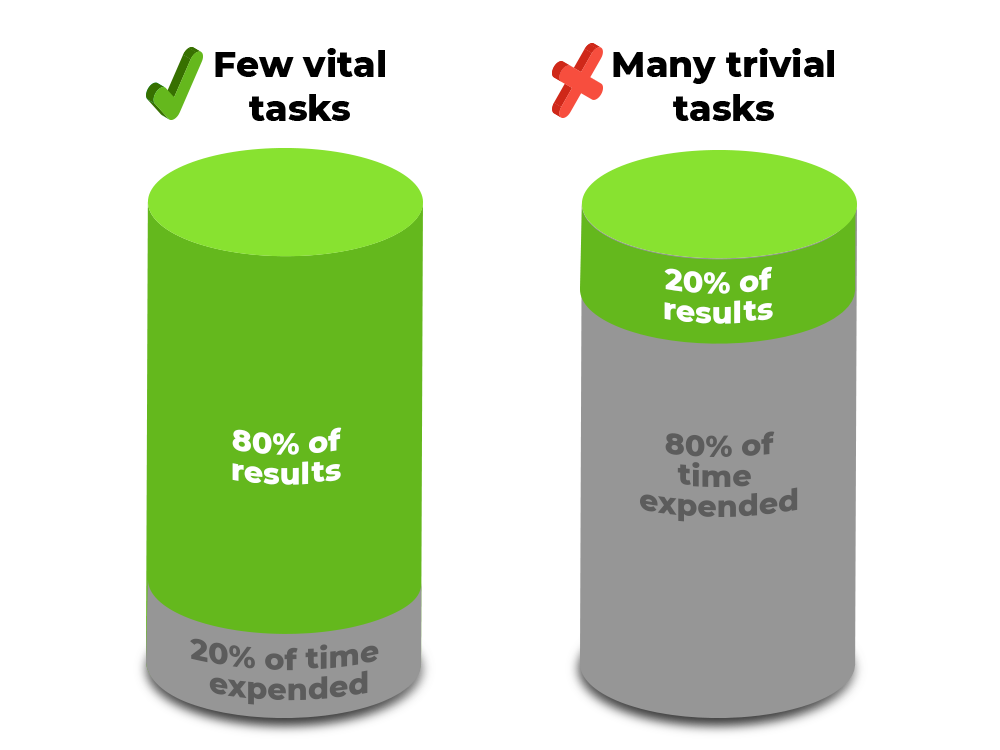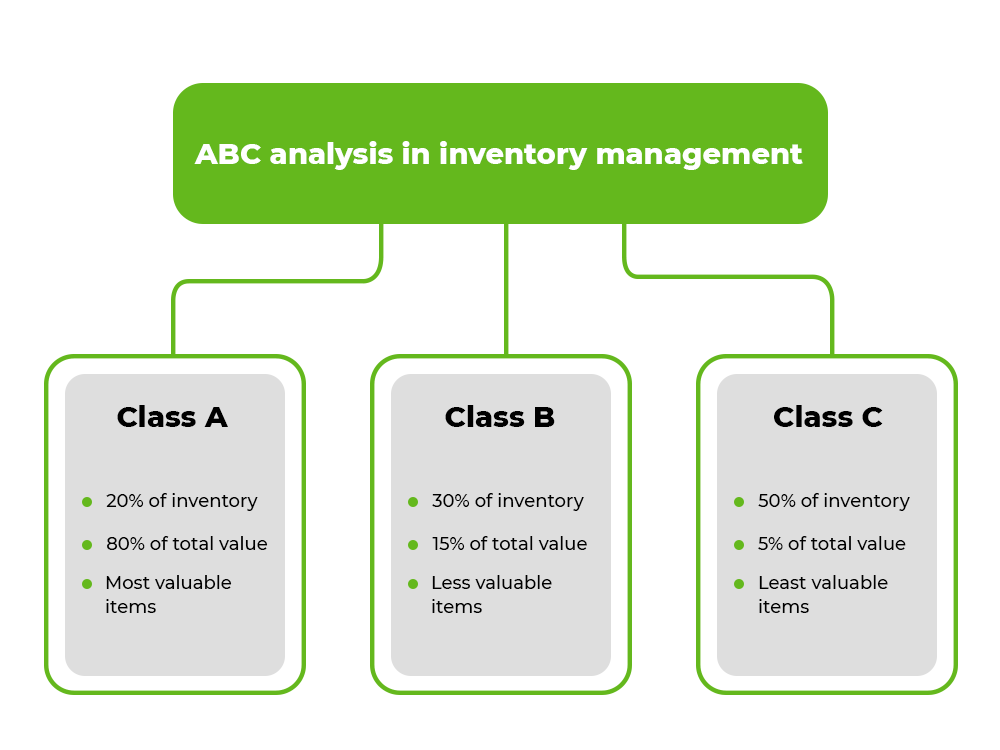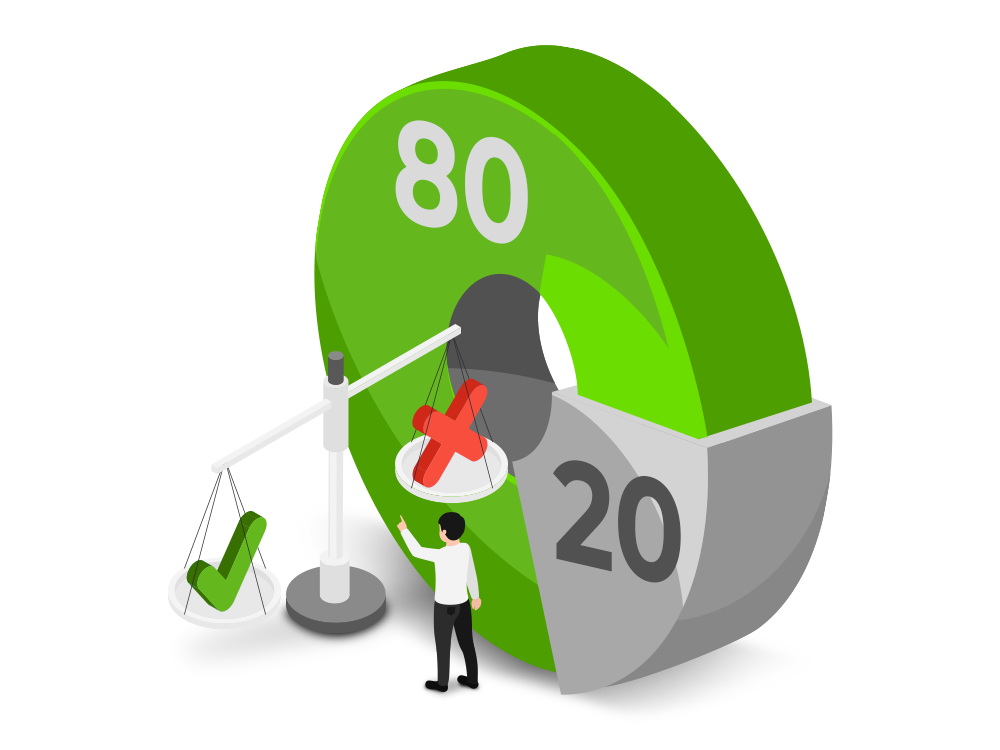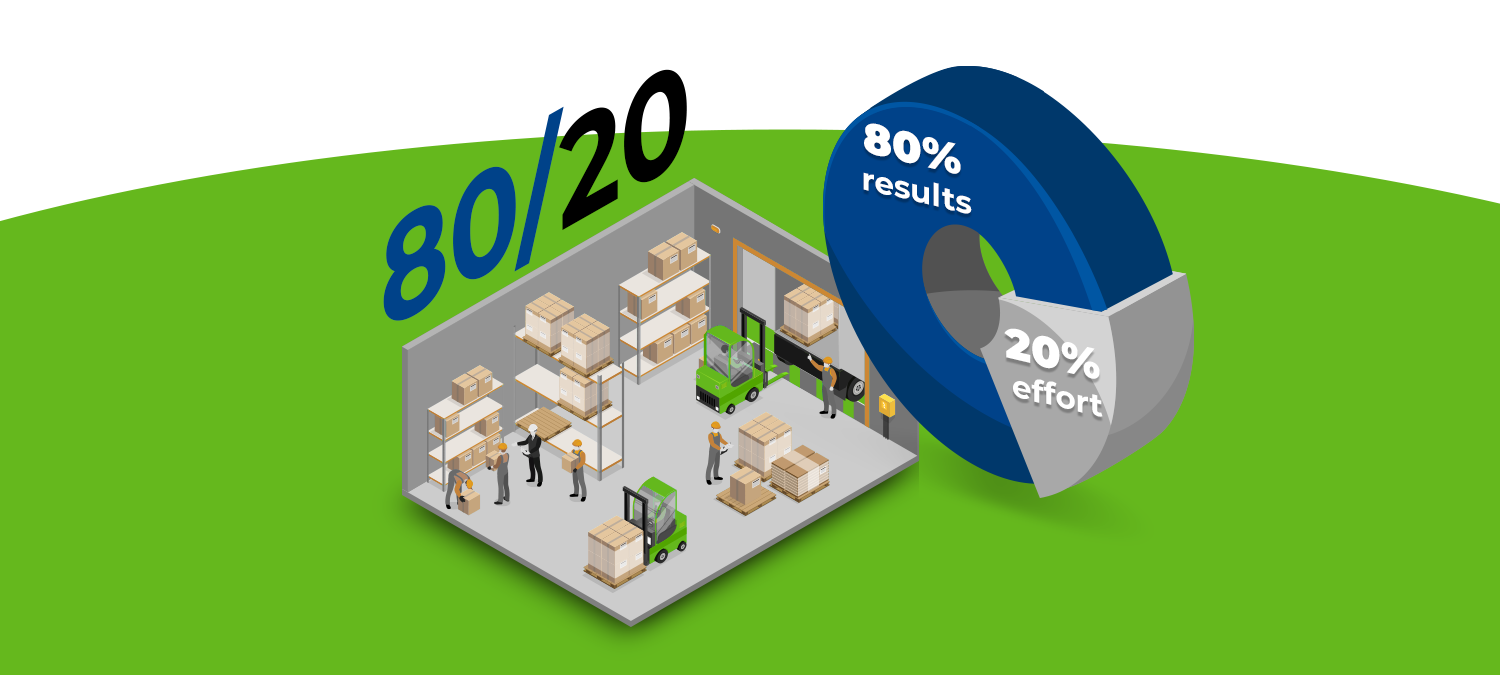Managing inventory is one of the most important aspects of running an efficient business, regardless of the size or industry of the company. Which products should be ordered in larger quantities? Which items should have reduced inventory levels? Incorrect decisions can lead to an oversupply of certain products in the warehouse or, conversely, a shortage of goods in demand. Ultimately, such situations can have a negative impact on your company’s financial position.
However, with the application of the 80/20 rule, also known as the Pareto Principle, inventory management questions will become more transparent and manageable. Its proper implementation can ensure more effective inventory control and increase the profitability of the company. What this rule is all about and how to implement it properly is explained below.
- What is the 80/20 inventory rule?
- Product Classification: How to Identify Priority Items?
- Advantages and Disadvantages of the 80/20 Inventory Rule (Pareto Principle)
- How to Implement the 80/20 Inventory Rule? Key Steps to Effective Inventory Management
- Conclusion
What is the 80/20 inventory rule?

The 80/20 rule, or the Pareto Principle, is based on the observations of the Italian economist and sociologist Vilfredo Pareto. In the early 20th century, he formulated the concept that approximately 80% of results depend on 20% of efforts. This principle was later generalized and applied to various aspects of life and business.
In the context of inventory management, the 80/20 rule asserts that approximately 80% of a company’s profits come from 20% of its inventory. This means that most items in inventory do not generate significant revenue, while a small number of items account for the majority of sales.
This philosophy has become the basis for developing a strategic approach to inventory management. It enables more efficient resource allocation by focusing resources on the most important items. This approach can help your company better understand which products are truly important to your business and which should receive special attention when making strategic inventory management decisions.
Product Classification: How to Identify Priority Items?
To manage inventories more systematically and focus attention on the crucial 20% of products, you can use the ABC analysis method. Based on the 80/20 rule, ABC analysis allows you to divide your inventories into three main categories according to their importance and impact on your company’s profitability.
However, it is important to first understand the general classification of inventories, as each category has its own characteristics and requires different management strategies. For example, finished goods may have higher costs and contribute significantly to revenue. Therefore, special attention may need to be paid to the accuracy of demand forecasting when managing them. On the other hand, raw materials and supplies may be less costly, but their availability is critical for uninterrupted production.
The general classification of inventory includes the following categories:
1. Raw Materials
Raw materials are materials or components used in the production process to manufacture end products. These materials can either be obtained from external sources or produced internally within the company.
2. Work in Progress (WIP)
This category includes semi-finished goods or products that are in the manufacturing process. They are not yet finished products and require further production steps.
3. Finished Goods
Finished goods are the final products that are either waiting to be shipped to customers or are already on their way to them.
4. Maintenance, Repair, and Operations (MRO)
This category includes items required for the technical maintenance, repair and smooth operation of a company’s facilities and infrastructure. These include, for example, tools, consumables, maintenance equipment and spare parts.
ABC analysis as an inventory management tool helps to more accurately classify inventory within each of these general categories based on their cost and importance. In this way, your company can determine which items should receive special attention and resources and which can be managed with less intensity.
Classification of items by profitability (ABC Analysis)

A Category (High-Value Items)
This category includes the items that make up the largest part of your company’s revenue. Although they only make up about 20% of your inventory, they are responsible for about 80% of your total profit. These are the most important items that should receive the most attention when managing inventory.
B Category (Moderate-Value Items)
The items in this category make up about 30% of your inventory and contribute about 15-20% to your revenue. They are important, but not as crucial as the items in category A.
C Category (Low-Value Items)
The remaining 50% of items fall into category C. They make up about half of your inventory, but only contribute about 5% to your revenue. The items in this category are less significant in terms of profitability. Their management may require fewer resources and attention than those in categories A and B.
Advantages and Disadvantages of the 80/20 Inventory Rule (Pareto Principle)
The 80/20 rule has proven its value in inventory management, assisting businesses in focusing their efforts and resources on the most critical items. However, like any strategy, it comes with its advantages and disadvantages. Understanding them will help you develop a more balanced perspective on the effectiveness of this strategy and make informed decisions in inventory management for your business.
Advantages of the 80/20 Inventory Rule:
1. Resource Optimization

Focusing on the top 20% of products that generate the majority of revenue allows for more efficient resource management and allocation of efforts.
2. Cost Reduction
Reducing inventory levels of less profitable items helps cut costs associated with storage and management. By following the 80/20 inventory rule, you can avoid excessive investments in low-profit items and concentrate efforts where they can yield greater benefits.
3. Increased Profitability
Optimizing your inventory can lead to increased profitability, as resources and attention are focused on the most profitable items.
Disadvantages of the 80/20 Inventory Rule:
1. Simplified Approach
Applying the 80/20 inventory rule simplifies the complex dynamics of management, overlooking various other factors such as seasonality, demand fluctuations, and more.
2. Ignoring Potential
Categorizing items may lead to ignoring potentially profitable items among the remaining 80% of inventory.
How to Implement the 80/20 Inventory Rule? Key Steps to Effective Inventory Management

After we’ve discussed what the 80/20 inventory rule is, its advantages and disadvantages, the question arises: ‘How do we implement this strategy?’ The answer to this question is the key to how your business can truly start reaping the benefits of this strategy. Implementing the Pareto principle requires careful and systematic work so that your business can maximize its potential and minimize risks.
1. Identify the Top 20% of Products Generating the Majority of Company Revenue
The first and most crucial step in applying the 80/20 inventory rule is to identify the products that generate the majority of your company’s revenue. Begin by conducting a thorough analysis of your product range. Examine the sales history, revenue, and turnover of each item over the past few years.
Consider not only the sales volume but also the profitability of the products. Some items may have a higher profit margin, making them even more crucial for your business’s profitability. Additionally, take into account seasonal factors and changes in demand that can impact the results.
2. Enhance Inventory Management Strategies
Review and optimize your inventory management strategies, taking into account the key products identified. Determine the appropriate inventory levels needed to meet demand for these products and how often they should be reordered. Monitor inventory levels to have the flexibility to avoid excessive inventory that can tie up your resources.
Also focus on promoting your key products. Develop marketing campaigns and promotions to drive sales and increase demand for these products. Highlight the value of these products to your customers and develop strategies to increase their popularity.
3. Monitor and Analyze Results
Regularly review and evaluate how your new strategies are impacting your company’s results. Continue to analyze sales, profitability and earnings data for key products. Compare the results to your expectations and goals.
If you see discrepancies between results and your expectations or changes in demand, you should adjust your inventory management strategies.
4. Optimize Inventory Management with Modern Technical Solutions
For more efficient inventory management, consider implementing inventory management software. With a reliable inventory management system, you can automate inventory-related processes and get an accurate, real-time overview of your stock levels. This is an important addition that will help you perform all of the above more effectively and streamline the entire inventory management process.
Conclusion

The 80/20 inventory rule is a valuable tool for improving inventory management that can bring significant benefits to your business. Effective management based on this principle helps strike a balance between meeting demand and minimizing costs, which is a key factor in a company’s success.
It’s important to remember that the practice of the 80/20 inventory rule is not without its drawbacks. This includes incomplete data and market fluctuations. Therefore, it should be used in conjunction with continuous monitoring and adjustment of inventory management strategies. This flexibility ensures that your approach remains effective in a dynamic business environment.
In combination with a modern inventory management system, the 80/20 inventory rule can significantly enhance the management process, enable more informed decision-making, boost company profitability, and make your business more competitive in the market.







